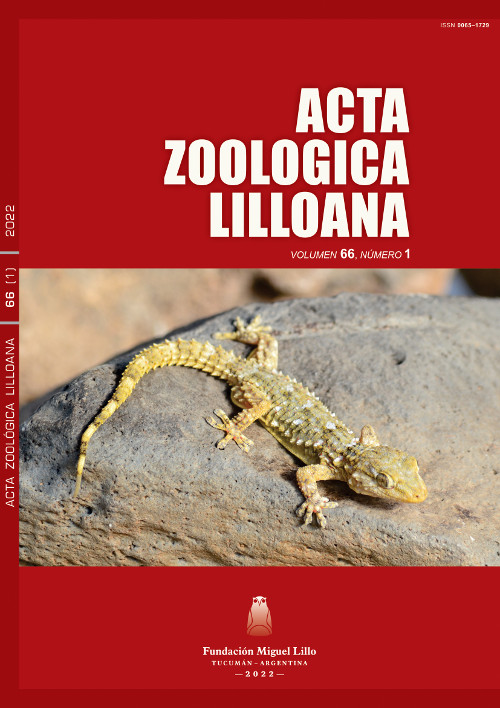The body mass index is influenced by the environment in populations of Artibeus planirostris (Chiroptera: Phyllostomidae)?
DOI:
Keywords:
Amazon, bats, flooded forest, Madeira riverAbstract
Bats are the second most diverse taxa of mammals in the world, after rodents. Some studies have evaluated if there is a relationship between the environment and the morphology of bats, because environmental conditions can have an important influence on the phenotype of the species. The aim of the present study is to evaluate the relationship between a morphological variable (body mass index - BMI) of populations of the species Artibeus planirostris and the environment, considering the climatic variation in two hydrographic basins of the center of the Brazilian Amazon. The hypothesis is that the BMI responds to the environmental variables of each site. This will be higher during the rainy season and in the high water period, responding to a high availability of resources, according to studies carried out in the same region. 400 bats were captured, of which 180 were males and 220 were females. Although the index seemed to show differences considering the sex of the individuals, both in the Madeiras river basin (ANOVA: gl = 1, F = 6.90, P = .00) and in the Purus river (ANOVA: gl = 1, F = 3.95, P = .01), there was no significant difference between the BMI and the different environments, considering the climate season. It is concluded that, in this study, no evidence was found to support the hypothesis about the influence of the environment on BMI in populations of the bat species Artibeus planirostris in the center of the Brazilian Amazon.
Downloads
References
Bonnacorso, F. (1979). Foraging and reproductive ecology in a panamanian bat community. Bulletin of the Florida State Museum. Biological sciences, 24, 359-408.
Caras, T., Korine, C. (2009). Effect of vegetation density on the use of trails by bats in a secondary tropical rain forest. Journal of Tropical Ecology, 25, 97-101.
Durán, A., Canchila, S. (2005). Ensamblaje de murciélagos (Mammalia: Chiroptera) en dos zonas del departamento de Sucre, Colombia. Acta Zoológica Mexicana (N.S.), 31, 358?366.
Fleming, T., Heithaus, E. (1981). Frugivorous bats, seeds shadows, and the structure of tropical forests. Biotropica, 13, 45-53.
Goulding, M., Barthem, R., Ferreira, E. (2003). The Smithsonian atlas of the Amazon. Washington: Smithsonian Institution Press.
Hollis, L. (2005). Artibeus planirostris. Mammalian Species, 775, 1-6.
Klingbeil, B., Willig, M. (2009). Guild-specific responses of bats to landscapes composition and configurations in fragmented Amazonian rainforests. Journal of Applied Ecology, 46, 203-213.
Lacki, M., Dodd, L., Toomey, R., Thomas, S., Couch, Z., Nichols, B. (2015). Temporal changes in body mass and body condition of cave-hibernating bats during staging and swarming. Journal of fish and wildlife management, 2, 1:11.
Lee, Y., Kuo, Y., Chu, W., Lin, Y., Chang, H., Chen, W. (2012). Ecomorphology, differentiated habitat use, and nocturnal activities of Rhinolophus and Hipposiderus species in east Asian tropical forests. Zoology, 115, 22-29.
Marchán, R., Larsen, P., Phillips, J., Strauss, R., Baker, R. (2012). On the association between environmental gradient and skull size variation in the great fruit-eating bat, Artibeus lituratus (Chiroptera: Phyllostomidae). Biological Journal of the Linnean Society, 105, 623-634.
Muñoz, J. 2001. Los murciélagos de Colombia. Sistemática, distribución, descripción, historia natural y ecología. Medellín: Editorial Universidad de Antioquia.
Peixoto, P., Lourenço, C., Freitas, K., Famadas, E. (2016). Host morphophysiological conditions and environment abiotic factors correlated with bat flies (Streblidae) prevalence and intensity in Artibeus Leach, 1821 (Phyllostomidae). Ciência Rural, 46, 648-653.
Pereira, M., Marques, J., Palmeirin, J. (2010). Ecological responses of frugivorous bats to seasonal fluctuations in fruit availability in Amazonian forest. Biotropica, 42, 680-687.
Pereira, M., Marques, J., Santana, J., Santos, C., Valsecchi, J., Lima, H., Beja, P., Palmeirin, J. (2009). Structuring of Amazonian bat assemblages: the roles of flooding patterns and floodwater nutrient load. Journal of Animal Ecology, 78, 1163–1171.
R Core Team. (2017). R: A language and environment for statistical computing. R Foundation for Statistical Computing.
Simmons, N. (2005). Order Chiroptera. En Mammal species of the world: a taxonomic and geographic reference. 3rd edition, Vol. 1. Baltimore: The Johns Hopkins University Press.
Speakman, J., Racey, P. (1985). The influence of body condition on sexual development of male Brown long-eared bats (Plecotus auritus) in the wild. Journal of Zoology, 210, 115-525.
Veloso, H., Rangel, A., Lima, J. (1991). Classificação da vegetação brasileira, adaptada num sistema universal. Rio de Janeiro: IBGE.
Wickham, H. (2009). Elegant graphic for data analysis. Luxemburgo: Springer-Verlag.
Downloads
Published
How to Cite
Issue
Section
License
Copyright (c) 2021 Acta Zoológica Lilloana

This work is licensed under a Creative Commons Attribution-NonCommercial-NoDerivatives 4.0 International License.









